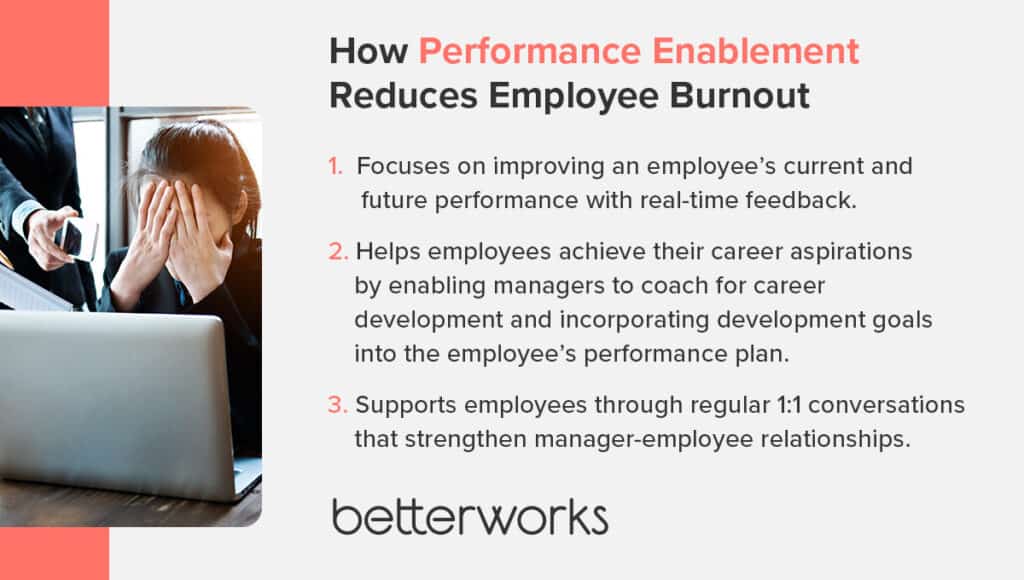Employee burnout is once again on the rise. According to recent research from Aflac, 59% of U.S. employees are experiencing at least moderate levels of burnout. As a human resources leader, you’re facing the dual pressures of improving employee performance while protecting people from burnout.
HR leaders can leverage performance enablement to help people achieve their potential without feeling overworked and overwhelmed. The performance enablement model of performance management provides employees with the control, autonomy, and empowerment they need to excel. This model can prevent burnout and reduce employee turnover.
Explore some of the ways performance enablement improves performance while building a healthier, happier company culture.
Focus on the future, not the past
Traditional performance management tends to save up feedback for weeks or months. Managers will use yearly or twice-yearly meetings to critique decisions and outcomes that employees might not even remember. Employees often don’t know what to expect from a performance review, and the focus on past actions can be demoralizing.
Performance enablement is the next evolution of performance management. This approach looks forward rather than backward. Continuous performance conversations allow managers to address behaviors in real-time. Managers and team members examine and learn from the past, but the focus is on improving performance going forward.
This shift has a big impact on preventing employee burnout. Legacy performance management processes can cause anxiety for employees, increasing their risk of burning out. Performance enablement conversations empower employees, who receive constructive feedback they can immediately apply. Instead of burning out, they can improve their performance and grow professionally.
Learning and growth never stop
One of the hallmarks of performance enablement is its relentless focus on fulfilling employee potential. That pursuit gives people a greater sense of autonomy and purpose within their careers, which can help prevent burnout.
In the performance enablement model, managers don’t just manage performance; they also help employees discover their strengths. Managers function as career coaches who help team members navigate the organizational chart.
Employees sometimes don’t know what options are available for internal mobility or career growth. They might need help determining an educational track that supports their goals. Goal alignment software enables the employee to work with their manager to incorporate career development goals into their performance plan and monitor progress. The software also makes the org chart visible so people can see the goals and activities of colleagues to gain a better sense of what their roles entail, and see related career tracks and skills-based opportunities. When such software is used as part of a performance enablement model, employees have powerful tools for self-directed growth.
Another key component is continuous performance conversations between managers and employees. Managers get the opportunity to learn more about each person’s interests and strengths. They can use that information to direct people to the learning opportunities best suited to their career goals.
You’ll see higher employee engagement and motivation when employees understand how they can grow into a role they love. Crucially, they’ll feel like they have control over their career trajectories. Feelings of being powerless or stuck in one’s career progression are major factors in burnout. Performance enablement offers a robust remedy.

Relationships power better experiences
Above all else, performance enablement is driven by relationships between managers and team members. Regular conversations strengthen that bond, building trust, producing better performance, and creating a better employee experience. When employees form close relationships with their managers, they feel more supported and empowered to take control of their careers.
Feeling supported helps prevent burnout. But without that support, it’s much harder for employees to find the balance between embracing growth-oriented challenges and taking on too much work.
Instead of saying “no” to a challenging assignment, for example, a team member who’s afraid to be honest about their workload capacity will say “yes,” then struggle to get everything done and feel high levels of stress. The result over time is poorer performance and worse mental health. But under a performance enablement model, that employee has built trust with their manager. They’ll raise concerns about their workload and find a fair solution. They’ll have the bandwidth to then pursue new skills and opportunities.

When employees and managers have strong relationships and mutual trust, team members are empowered to discuss potential career tracks, learning opportunities, or goals. After all, performance enablement is a collaborative process, and employees play a big part in setting their own goals. When they have the autonomy to start the conversation, they’re more likely to achieve that growth and drive better business outcomes — without succumbing to burnout.
When you encourage and enable employees to think strategically, you unleash their performance potential. By helping them grow, you reduce the likelihood of burnout and put people on a path to happy, healthy high performance.
Learn about five employee burnout signs and what to do about them.







